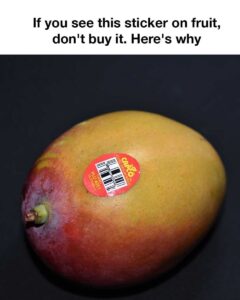
Fruit stickers are small labels that are often found on fruits and vegetables in grocery stores. These stickers serve multiple purposes, including providing information about the produce’s origin, type, and price. They are essential for inventory management and help cashiers identify the correct price for each item. However, beyond their logistical utility, these stickers can also offer consumers valuable insights into how the produce was grown, which can influence purchasing decisions.
Understanding PLU Codes on Fruit
PLU codes, or Price Look-Up codes, are numerical codes found on fruit stickers. These codes are typically four or five digits long and are used worldwide to identify bulk produce. PLU codes are standardized by the International Federation for Produce Standards (IFPS) and help retailers manage inventory and pricing. Understanding these codes can empower consumers to make informed choices about the produce they purchase.
The Significance of PLU Code Digits
The number of digits in a PLU code and the digits themselves carry specific meanings. A four-digit PLU code indicates that the produce was conventionally grown, while a five-digit code starting with the number 9 signifies organic produce. A five-digit code beginning with the number 8 indicates that the produce is genetically modified. Recognizing these distinctions is crucial for consumers who are concerned about the methods used to grow their food.
Identifying Genetically Modified Produce
Genetically modified produce is identified by a five-digit PLU code that starts with the number 8. These fruits and vegetables have been altered at the genetic level to exhibit certain traits, such as resistance to pests or longer shelf life. While genetically modified organisms (GMOs) are deemed safe by many scientific organizations, some consumers prefer to avoid them due to health, ethical, or environmental concerns.
Recognizing Conventionally Grown Produce
Conventionally grown produce is labeled with a four-digit PLU code. This type of produce is grown using traditional agricultural methods, which may include the use of synthetic fertilizers, pesticides, and herbicides. While these practices can increase yield and reduce costs, they may also raise concerns about chemical residues and environmental impact.
Spotting Organic Produce Through PLU Codes
Organic produce is marked with a five-digit PLU code starting with the number 9. Organic farming practices avoid synthetic chemicals, focusing instead on natural fertilizers and pest control methods. Organic produce is often preferred by consumers who are concerned about chemical exposure and environmental sustainability.
Why You Should Avoid Certain PLU Codes
Consumers may choose to avoid certain PLU codes based on personal health concerns, environmental considerations, or ethical beliefs. For example, those wary of genetically modified foods might steer clear of PLU codes starting with 8. Similarly, individuals concerned about pesticide exposure might opt for organic produce with PLU codes beginning with 9.
Health Implications of Consuming Genetically Modified Produce
The health implications of consuming genetically modified produce are a topic of ongoing debate. While many studies have found GMOs to be safe for consumption, some consumers worry about potential long-term health effects. Concerns include allergenicity, antibiotic resistance, and unknown health risks, prompting some to avoid GMOs altogether.
Environmental Impact of Conventionally Grown Produce
Conventionally grown produce can have significant environmental impacts due to the use of synthetic fertilizers and pesticides. These chemicals can lead to soil degradation, water pollution, and loss of biodiversity. Additionally, conventional farming practices often rely on monocultures, which can reduce ecosystem resilience and increase vulnerability to pests and diseases.
Benefits of Choosing Organic Produce
Choosing organic produce offers several benefits, including reduced exposure to synthetic pesticides and fertilizers. Organic farming practices promote soil health, conserve water, and enhance biodiversity. Consumers who prioritize environmental sustainability and health may find organic produce to be a more appealing option.
How to Make Informed Choices When Buying Fruit
To make informed choices when buying fruit, consumers should familiarize themselves with PLU codes and understand what they signify. By being aware of the differences between conventional, organic, and genetically modified produce, shoppers can align their purchases with their health, environmental, and ethical priorities. Additionally, seeking out local and seasonal produce can further support sustainable agriculture.
Conclusion: Making Healthier and More Sustainable Choices
Understanding fruit stickers and PLU codes empowers consumers to make healthier and more sustainable choices. By recognizing the differences between conventional, organic, and genetically modified produce, individuals can select fruits and vegetables that align with their values and health goals. In doing so, consumers can contribute to a more sustainable food system and promote their well-being.



